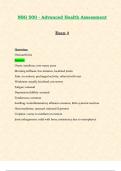NSG 500 - Advanced Health Assessment Exam 3 Question: Osteoarthritis Answer: Onset: insidious, over many years Morning stiffness: few minutes, localized joints Pain: on motion, prolonged activity, relieved with rest Weakness: usually localized, not severe Fatigue: unusual Depression/lab ility: unusual Tenderness: common Swelling: noninflammatory effusion common, little synovial reaction Heat/erythema: unusual, minimal if present Crepitus: coarse to medium on motion Joint enlargement: mild with bony consistency due to osteophytes Question: Rheumatoid Answer: Onset: gradual (weeks to months) or sudden (24 -48 hours) Morning stiffness: several hours Pain: even at rest, may disturb sleep Weakness: often pronounced, out of proportion with muscle atrophy Fatigue: often severe, onset 4 -5 hours after rising Depression/lability: common, coinciding with fatigue and disease activity, often relieved if in remission Tenderness: almost always, most sensitive indicator of inflammation Swelling: fusiform soft tissue enlargement, inflammatory ef fusion common, synovial proliferation and thickening, symmetric, rheumatoid nodules Heat/erythema: Sometimes present Crepitus: medium to fine Joint enlargement: moderate to severe if an inflammatory effusion is present Question: RA subjective/objective Answer: -joint pain/stillness especially in morning -constitutional symptoms: fatigue, myalgia, weight loss, low grade fever -cause unknown Question: how to identify scoliosis Answer: -lateral curvature or rib hump during flexion to touch toes -uneven shoulder and hip levels; may have crease on one side at the waist -looks like an s or c Question: gout Answer: -onset of hot/swollen joint, exquisite pain, limited ROM -primarily affects men over 40, postmenopausal women -usually the proximal p halanx of the great toe, can also be in wrists, hands, ankles, knees -skin over joint appears shiny/red/purple -uric acid crystals form as tophi under skin with chronic gout Question: OA: onset/subjective Answer: -onset after 40 years, 100% after 75 yea rs old -many have enlarged joints due to bone growths (osteophytes)




